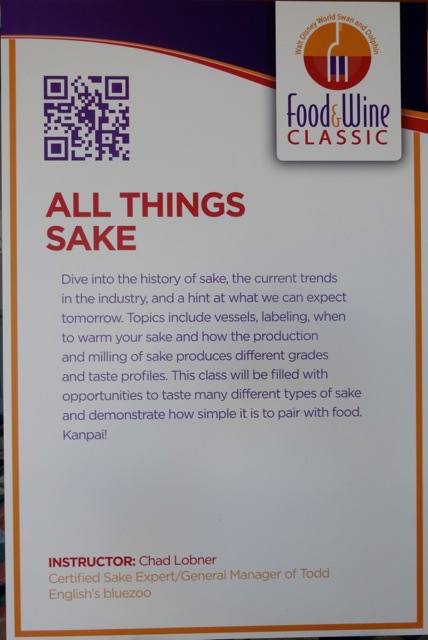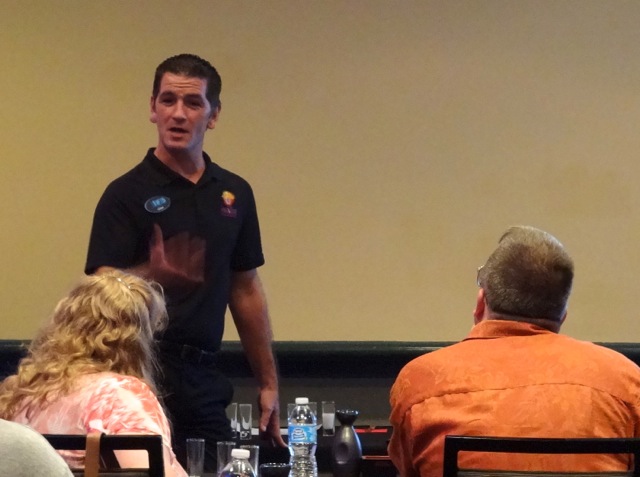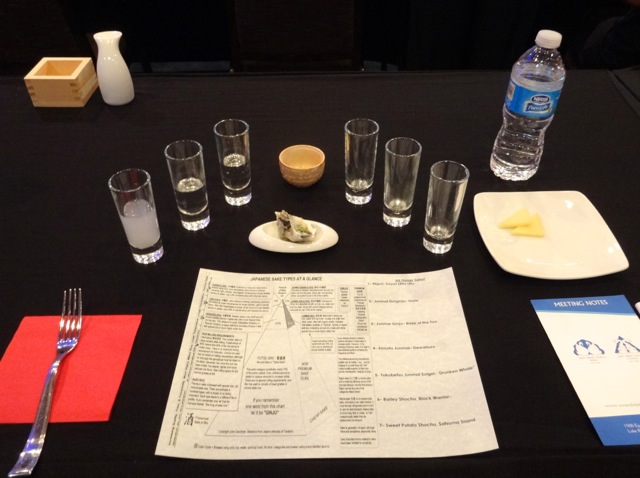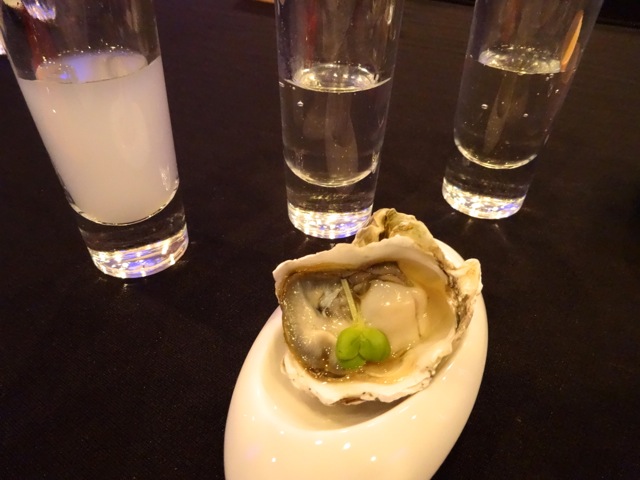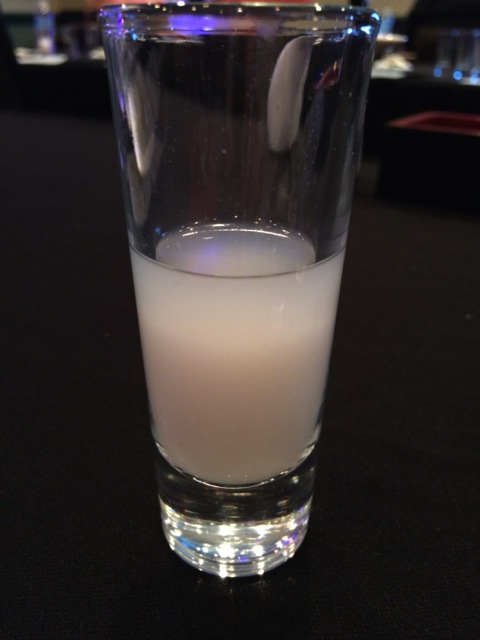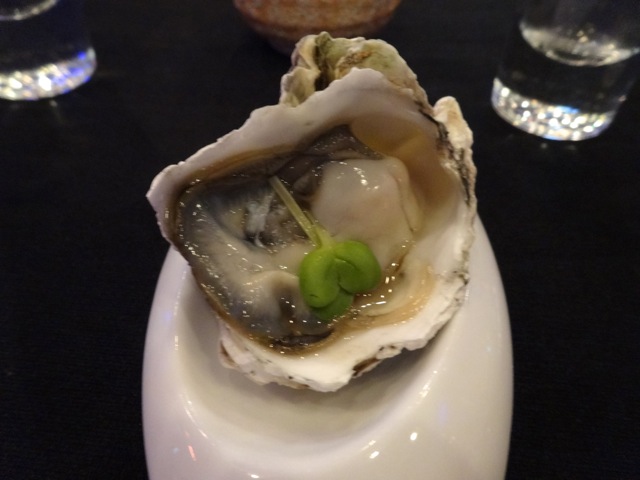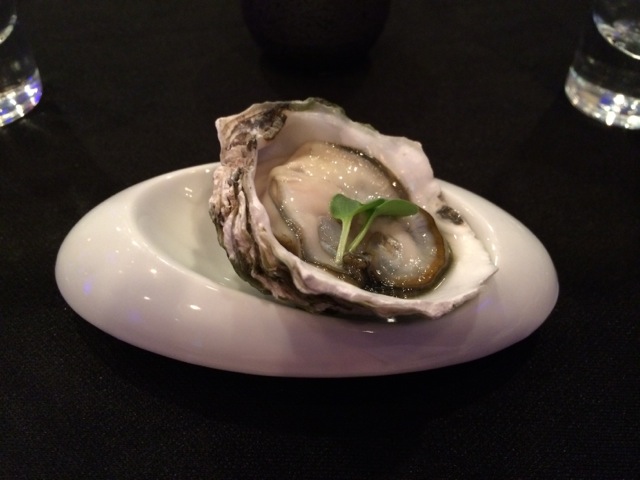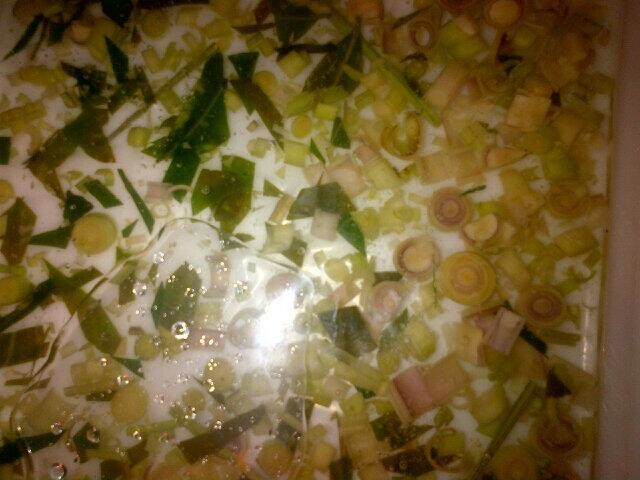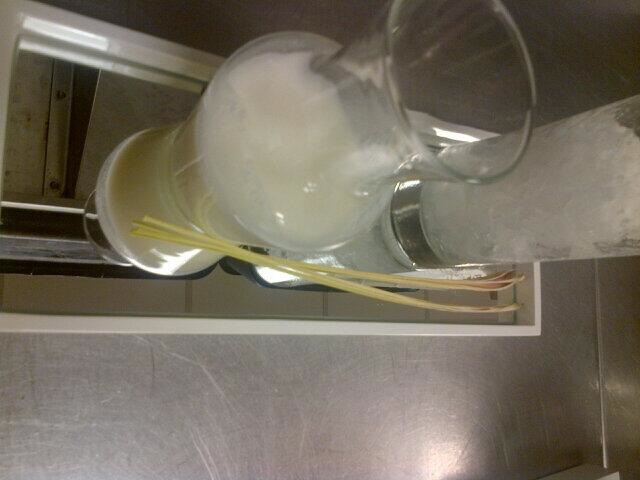This is the fourth year that we’ve attended Chad Lobner’s “All Things Sake!” seminar during the Swan & Dolphin Food & Wine Classic – and we’re never disappointed. Joe was there also, just as in years past. Chad and Joe are both pretty passionate about sake, and it definitely comes across.
I’ll spare you all the technical and historical stuff about how sake is made, you can find lots of that in our posts from 2010, 2011, and 2012.
We tasted 8 items (1 was a cocktail, 2 were shochu, and 5 were sakes). The food offering, looked better than last year’s… Yum! Oysters and Cheese (cheese with sake? hmmm, that seems a bit unusual).
The first sake was a nigori (some of the rice lees are added back in or simply left in, so it’s milky or cloudy)…
You can see how the solids (rice lees) had begun to give up to gravity, they are settling to the bottom of the sake glass. This is Nigori, Sauyri Little Lily (Chad suggested that this sake be paired with spicy foods). The cloudiness means that a nigori is going to be creamier than clear sakes and also it will be sweeter. There were banana and cantaloupe undertones, maybe some coconut and lychee too.. The taste is slightly tropical.
The second sake, Junmai Daiginjo Horin was paired with the oyster. Chef Bobby and Chad used Kumomotos Oysters with dashi to pair with this sake… the sake is creamy and the oysters are buttery… Chad said that the food and the sake amplified each other.
Nick noted that he didn’t get anything on the nose of the sake, the taste had a lot of forward alcohol. The pairing with the oyster was nice, but it was almost too rich and buttery. I detected pineapple and nutty chocolate on the nose, when I tasted it… loads of alcohol but it was light on the tongue. I liked it more as I kept tasting. The pairing was okay, but oysters go down so quickly that it wasn’t possible for me to keep tasting (maybe I should have gone and swiped an oyster from an empty spot at the table?).
The third sake was Junmai Ginjo, Bride of the Fox. Nick’s notes: slight anise on the nose, hints of unripe canteloupe, and some floral notes. He noted that this one has a much lower alcohol taste than the second sake. I detected light florals on nose, almost not alcohol on tasting, it was light and slightly sweet. Chad said that this could be called a Daiginjo (it’s up to the sake maker, if the sake can be classified at a higher level, the sake maker can decide to call it by the lower level if he wishes)… he also said that this one would be good with sushi, excellent with octopus, squid or clams.
The fourth sake, Kimoto Junmai, Dwatsuru was supposed to be racier, gamier, and sweeter and it was paired with Morimoto buckwheat soba aged cheddar (cheese & sake?). Nick really liked the smell of this one, he said that it was the “cleanest smelling, like the sea” and while he liked the pairing, the fat from the cheese seemed to be almost too much for the sake. I thought that the nose was pleasant (not what I’d usually associate with gamey) and the taste was more masculine than the other sakes tonight – I liked the pairing of the sake with cheese quite a bit.
There was one more sake to taste, Tokubetsu Jumai Suigei, Drunken Whale – tokubetsu means “special” and this is designated by the sake brewer, not by a governmental regulation. Nick notes that this one has a “fresh nose, but not like the sea, more like spring” and that the alcohol was on the sides of the tongue (not the back) – this made it harder to nail down the flavor. I thought it had a tropical and pineapple nose, the taste was pleasant, smoother than the other sakes, I’d even call it “slippery” – I really liked it.
I mentioned earlier that we had a special cocktail… Chad said there had been some interest in shochu (50 proof, less calories and alcohol than vodka, a couple of the reasons its popular in Japan – you’re likely to encounter it when out for a night of drinking in Japan, mixed with flavored sodas and such), so he decided to create a shochu cocktail for us… (note, it can be spelled “shochu” or “soju” or just about any way as long as you pronounce it right)…
Okay, the cocktail, we had seen Chad’s tweet about 2 days before the event
Lemon grass and kaffir lime infused soju… Guaranteed not to suck…
@TeamTYKUpic.twitter.com/M5aSBSEKGq
Then the next day, he tweeted a new cocktail…
Kaffir lime and lemon grass scented
@TeamTYKU soju…coconut milk, meyer lemon nitro foam, licor 43, lemon bitters pic.twitter.com/fESDaz33a3
We know that Chad’s a mad scientist when it comes to cocktails, but Nick was really thinking – “ummm, not for me because I don’t like lemongrass much”… No worries, he just won’t order it if it ends up on bluezoo’s cocktail menu. Well, you’ve probably guessed by now that this is the special cocktail we were served at the seminar. What did we think? It was GREAT, we both liked it A LOT. Chad said it may find it’s way onto the bluezoo menu at some point, no name as of yet, then he said “well, maybe it should be One Night in Tokyo“… I thought that was hilarious! And fitting!
Only two items left to go… shochu x 2.
The first one was Barley Shochu, Black Warrior – we didn’t care for it very much. Nick thought it was very rough without a lot of flavor other than “light alcohol”. I thought that it smelled really sweet and odd, kind of like craft glue and the taste was like a faintly sweet vodka.
The second one was Sweet Potato Shochu, Satsuma Snami – whew! This stuff smelled like the sheds where they used to “cook soil” when we were in college! I thought it even tasted like dirt… Joe suggested that this would be better with some ice and a pickled plum in the bottom of the glass… Okay, if he says so… We didn’t finish this, nor did anyone in our group.
A really fun experience, we had three friends with us (so we were five of the 16 guests at the seminar). It’s become such a tradition for us that it’s hard to imagine not doing the sake class during the Food & Wine Classic.
——-
Okay, story time. We were in college beginning in 1983. We went to a land grant university in the southern United States. And since it was a land grant university, there were lots of degrees in agriculture, horticulture, soil science, biology, etc… On our way from the dormitories (and later the parking lot after we moved off campus) to most of our classes, we walked past the research greenhouses on campus. Well, did you know that the soil in those greenhouses has to be sterilized before using it again? Makes sense when you stop and think about it, but who thinks about sterilizing soil? They sterilized the soil by “cooking” it – basically it was moistened and baked… It stunk. It stunk in a very unique way. I don’t think I’ve ever smelled anything quite like it – until tonight with the sweet potato soju.
